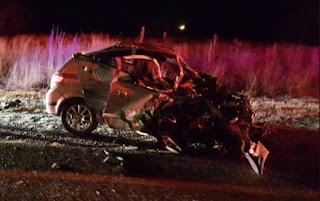 |
| The Cherry QQ after a sub-60km/h head-on crash. |
The little Chinese hatch received an “acceptable” safety score among its affordable peers.
The report considered the safety features of 25 small hatches currently retailing for under R160 000 in SA.
In terms of the number of safety features, the Toyota Aygo and Nissan Micra 1,2 Visia+ scored over 50 points, with the Renault Kwid 1,0 Expression, Kia Picant 1,0 Start and Datsun Go+ 1,2 Lux topping the poor safety rating. The Chery scored only moderately, ahead of the Chevrolet Spark 1,2 Curve and Mitsubishi Mirage 1,2 GL.
The AA said in a statement price remains main driving factor in people’s decisions to buy vehicles and the report aimed to highlight the importance of safety features in new cars and encourage car buyers to consider safety — not only price — to avoid adding to last year’s death toll on SA’s roads
of 14 071 people.
The association notes this is especially important as many of the people who are buying or driving entry-level vehicles are often those with the least driving experience and, as such, this makes safety features even more critical.
 |
| Seven people died in this hatch in a typical high-speed head on crash in South Africa. |
The 25 vehicles surveyed for the second instalment of the Entry-Level Vehicle Safety Report were evaluated against the number of active safety features they have (anti-lock braking systems, electronic stability control), and passive safety features (airbags).
A commendable finding, however, is that 11 of the 25 identified vehicles have ABS and electronic brake-force distribution (EBD) installed — a positive step towards increasing the overall safety of vehicles.
None of the vehicles in this year’s sample was crash-tested by the EURO New Car Assessment Programme (NCAP), which the AA only uses if the models sold in SA are identical to the one tested in Europe.
Instead, the AA uses a point-based system with weights allocated to safety features.
Active safety features such as ABS and ESC were given the most significant weights (30 points each), while each airbag scored 10.
The only exception is the curtain airbag, which scores 20 points, as studies show these airbags can dramatically reduce life threatening head injuries by up to 50%.
The survey is the result of desktop research, and specifically assesses safety features only. It does not consider the structural integrity of the driver/passenger compartment.
The 25 vehicles are then categorised into three groups based on their safety ratings according to the AA survey. These cars are noted for having either:
•Acceptable safety,
•Moderate safety, or,
•Poor safety.
A full list of the vehicles assessed, their safety ratings, and their Safety/Affordability scores, is available at https://aa-sa.co/ELVS-report.